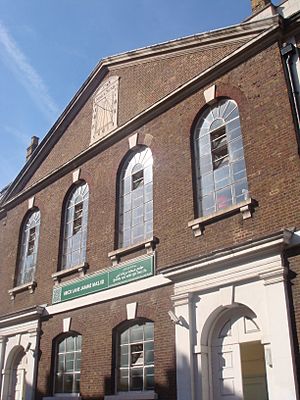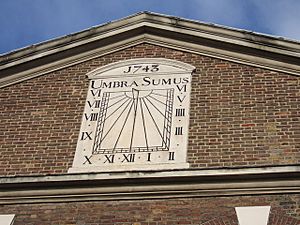Brick Lane Mosque facts for kids
Quick facts for kids Brick Lane Jamme Masjid |
|
|---|---|
 |
|
| Religion | |
| Affiliation | Sunni |
| Leadership |
|
| Location | |
| Location | Brick Lane, Tower Hamlets, London, United Kingdom |
| Architecture | |
| Architectural type | Mosque |
| Architectural style | Georgian architecture |
| Date established | 1743 (built), 1976 (mosque) |
| Specifications | |
| Capacity | 3,200 (including women) |
| Minaret(s) | 1 |
The Brick Lane Mosque, also called Brick Lane Jamme Masjid, is a special place of worship for Muslims in London. It's located in the East End of London and is very important to the British Bangladeshi community there.
This building at 59 Brick Lane has a long and interesting history. Since it was built in the mid-1700s, it has been used by different religious groups. This shows how many different people have moved to the Spitalfields area over the years. The building is so important that it's a Grade II* listed building, meaning it's protected for its history.
Contents
A Building with Many Stories
The Brick Lane Mosque building has changed its purpose many times. It has served as a place of worship for Christians, then Jews, and now Muslims. Each change reflects the different communities that have lived in the area.
From Chapel to Church: Christian Beginnings
The building first opened in 1743 as a Protestant chapel. It was called "La Neuve Eglise," which means "the New Church." This chapel was built by the Huguenot community. Huguenots were French Protestants who came to London to escape religious persecution in France. Many of them settled in Spitalfields and were skilled in silk weaving. Since they were not part of the official Church of England, they built their own chapels. The building was a Huguenot chapel for over 60 years.
Later, in 1809, it became a Wesleyan chapel. It was known as The Jews' Chapel for a short time. After about 10 years, it became a regular Methodist chapel in 1819.
A Synagogue for Jewish Communities
In 1891, the building changed again. It became a synagogue, a Jewish place of worship, called the Machzike Hadath, or Spitalfields Great Synagogue. At this time, many Jewish people from Russia and Central Europe were moving to the area. They were escaping difficult times in their home countries. Between the 1880s and early 1900s, about 140,000 Jewish people from Eastern Europe settled in Britain.
A famous leader of the synagogue from 1916 was Abraham Isaac Kook. He later became the first chief rabbi for Ashkenazi Jews in Mandatory Palestine. Over time, many Jewish families moved to other parts of London. The synagogue eventually moved to a new location in Golders Green.
A Mosque for the Bangladeshi Community
By the 1970s, many people from Bangladesh had moved to the Spitalfields and Brick Lane areas. They came to Britain looking for work, often in factories and the textile industry. This growing community needed a place to worship. So, in 1976, the building at 59 Brick Lane was bought and updated. It then reopened as a mosque, called the London Jamme Masjid.
Today, the mosque serves the largest group of Bangladeshi Muslims in the country. It can hold up to 3,200 people, including 200 women. The mosque is busiest during the jummah prayers on Friday. All sermons are given in English, Arabic, and Bengali. The mosque follows the traditions of Sunni Islam. It also works closely with the Bangladesh Welfare Association to help with community needs. Children can take Arabic and their mother tongue classes on the top floors.
The Brick Lane Mosque was once known as the London Great Mosque. However, larger mosques have since opened in London, like the London Central Mosque (1978) and the East London Mosque (1985).
See also
- Islam in the United Kingdom
- Islamic schools and branches
- List of mosques
- List of mosques in the United Kingdom
- Saheb Qiblah Fultali
- Sufism


